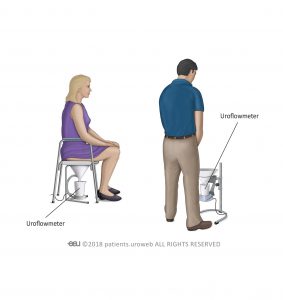Table of Contents [hide]
Why a urodynamic test is done
A urodynamic test is done to get more information about your urination cycle and how your bladder muscles work. There are several urodynamic tests which your doctor may use to better understand your condition. These include uroflowmetry and cystometry.
Overactive bladder symptoms can point to other conditions. Part of the diagnosis is ruling out other possible explanations for the symptoms, such as urinary infection or diabetes.
Preparation
The tests usually don’t need a lot of preparation, but it is important to check in advance with a urine sample that no infection is present. Also check if you need to stop any medicine intake. The tests take about 30 minutes to complete.
If you have an infection, you should be treated with antibiotics before the urodynamic study can take place. Please bring the results of the urinary test to your appointment.
How is the urodynamic test done?
Urine flow test
- Your health care provider may first start with the urine flow test.
- You’re given some privacy and asked to urinate in a special toilet. This toilet measures the force and flow of your urine (See Fig.1).
- After that, an ultrasound of your bladder is done to see how well it emptied.
Cystometry
- If you also need cystometry, you will be in a lying, seating or standing position.
- With a local anaesthetic, a catheter is inserted in your urethra. Another catheter is placed in your rectum.
- Both catheters measure the pressure in your bladder and your abdomen.
- Sensors on your abdomen monitor the activity of the pelvic muscles.
- Using the catheter, the doctor will fill your bladder with a sterile fluid and ask you to cough or bear down to test your bladder reaction.
- The doctor checks if there is any leakage of urine and if you feel the need to urinate.
- When your bladder is completely full, you are asked to empty your bladder while pressure is being recorded. At the end of the cystometry test, the catheters and sensors are removed.
The procedure
This animation shows how a typical urodynamic test is performed.
Follow-up
Right after the tests are done, your doctor will discuss the results with you, and any further treatment you may need. Drink plenty of liquids after the tests to reduce discomfort while urinating.


